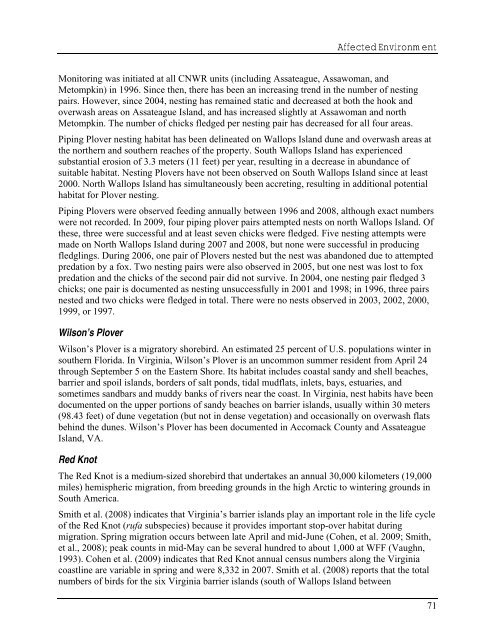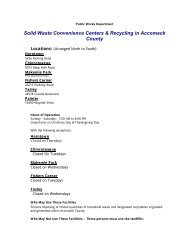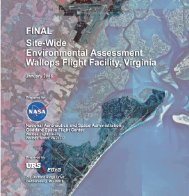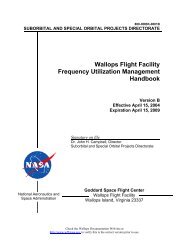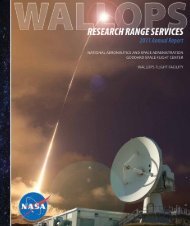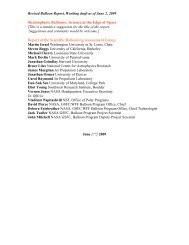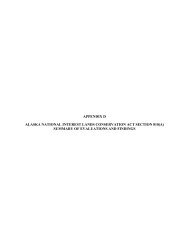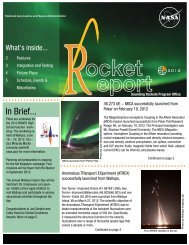Alternative Energy Draft EA - NASA Visitor Center at Wallops Flight ...
Alternative Energy Draft EA - NASA Visitor Center at Wallops Flight ...
Alternative Energy Draft EA - NASA Visitor Center at Wallops Flight ...
You also want an ePaper? Increase the reach of your titles
YUMPU automatically turns print PDFs into web optimized ePapers that Google loves.
Affected Environment<br />
Monitoring was initi<strong>at</strong>ed <strong>at</strong> all CNWR units (including Ass<strong>at</strong>eague, Assawoman, and<br />
Metompkin) in 1996. Since then, there has been an increasing trend in the number of nesting<br />
pairs. However, since 2004, nesting has remained st<strong>at</strong>ic and decreased <strong>at</strong> both the hook and<br />
overwash areas on Ass<strong>at</strong>eague Island, and has increased slightly <strong>at</strong> Assawoman and north<br />
Metompkin. The number of chicks fledged per nesting pair has decreased for all four areas.<br />
Piping Plover nesting habit<strong>at</strong> has been deline<strong>at</strong>ed on <strong>Wallops</strong> Island dune and overwash areas <strong>at</strong><br />
the northern and southern reaches of the property. South <strong>Wallops</strong> Island has experienced<br />
substantial erosion of 3.3 meters (11 feet) per year, resulting in a decrease in abundance of<br />
suitable habit<strong>at</strong>. Nesting Plovers have not been observed on South <strong>Wallops</strong> Island since <strong>at</strong> least<br />
2000. North <strong>Wallops</strong> Island has simultaneously been accreting, resulting in additional potential<br />
habit<strong>at</strong> for Plover nesting.<br />
Piping Plovers were observed feeding annually between 1996 and 2008, although exact numbers<br />
were not recorded. In 2009, four piping plover pairs <strong>at</strong>tempted nests on north <strong>Wallops</strong> Island. Of<br />
these, three were successful and <strong>at</strong> least seven chicks were fledged. Five nesting <strong>at</strong>tempts were<br />
made on North <strong>Wallops</strong> Island during 2007 and 2008, but none were successful in producing<br />
fledglings. During 2006, one pair of Plovers nested but the nest was abandoned due to <strong>at</strong>tempted<br />
pred<strong>at</strong>ion by a fox. Two nesting pairs were also observed in 2005, but one nest was lost to fox<br />
pred<strong>at</strong>ion and the chicks of the second pair did not survive. In 2004, one nesting pair fledged 3<br />
chicks; one pair is documented as nesting unsuccessfully in 2001 and 1998; in 1996, three pairs<br />
nested and two chicks were fledged in total. There were no nests observed in 2003, 2002, 2000,<br />
1999, or 1997.<br />
Wilson’s Plover<br />
Wilson’s Plover is a migr<strong>at</strong>ory shorebird. An estim<strong>at</strong>ed 25 percent of U.S. popul<strong>at</strong>ions winter in<br />
southern Florida. In Virginia, Wilson’s Plover is an uncommon summer resident from April 24<br />
through September 5 on the Eastern Shore. Its habit<strong>at</strong> includes coastal sandy and shell beaches,<br />
barrier and spoil islands, borders of salt ponds, tidal mudfl<strong>at</strong>s, inlets, bays, estuaries, and<br />
sometimes sandbars and muddy banks of rivers near the coast. In Virginia, nest habits have been<br />
documented on the upper portions of sandy beaches on barrier islands, usually within 30 meters<br />
(98.43 feet) of dune veget<strong>at</strong>ion (but not in dense veget<strong>at</strong>ion) and occasionally on overwash fl<strong>at</strong>s<br />
behind the dunes. Wilson’s Plover has been documented in Accomack County and Ass<strong>at</strong>eague<br />
Island, VA.<br />
Red Knot<br />
The Red Knot is a medium-sized shorebird th<strong>at</strong> undertakes an annual 30,000 kilometers (19,000<br />
miles) hemispheric migr<strong>at</strong>ion, from breeding grounds in the high Arctic to wintering grounds in<br />
South America.<br />
Smith et al. (2008) indic<strong>at</strong>es th<strong>at</strong> Virginia’s barrier islands play an important role in the life cycle<br />
of the Red Knot (rufa subspecies) because it provides important stop-over habit<strong>at</strong> during<br />
migr<strong>at</strong>ion. Spring migr<strong>at</strong>ion occurs between l<strong>at</strong>e April and mid-June (Cohen, et al. 2009; Smith,<br />
et al., 2008); peak counts in mid-May can be several hundred to about 1,000 <strong>at</strong> WFF (Vaughn,<br />
1993). Cohen et al. (2009) indic<strong>at</strong>es th<strong>at</strong> Red Knot annual census numbers along the Virginia<br />
coastline are variable in spring and were 8,332 in 2007. Smith et al. (2008) reports th<strong>at</strong> the total<br />
numbers of birds for the six Virginia barrier islands (south of <strong>Wallops</strong> Island between<br />
71


